The Spatial–Temporal Variation of Tropospheric NO2 over China during 2005 to 2018
Abstract
1. Introduction
2. Data and Methods
2.1. OMI NO2 Vertical Column Density (VCD) Product
2.2. Meteorological Data Set
2.3. Trends Analysis Methods
3. Results and Discussion
3.1. Spatial Distribution and Long-Term Trends of Tropospheric NO2 at the National Scale
3.2. Spatial Distribution and Long-Term Trends of Tropospheric NO2 VCD at the Five Hotspots
3.3. Monthly and Seasonal Patterns of Tropospheric NO2 VCD
3.4. Impacts of Meteorological Conditions
4. Conclusions
- (1)
- The NO2 pollution in China is significant, and the distribution of tropospheric NO2 VCD is uneven. This pollution is higher in southeastern China and lower in the northwest, which is well divided by the Heihe–Tengchong line. In addition, the North China Plain is the region over eastern China with the highest NO2 columns. Then, five areas with high NO2 columns in southeast China were selected for detailed discussion, including Jing–Jin–Tang, the combined regions of Northern Henan and Southern Hebei, Jinan in the Shandong Province, Yangtze River Delta and Pearl River Delta.
- (2)
- NO2 concentrations show long-term variability that varies regionally. On the one hand, the concentration of NO2 in the Pearl River Delta has been in a slow but steady decline apart from slight increases in 2007 and 2010. On the other hand, the annual variation in the NO2 columns displays two different stages in the other four areas. First, the NO2 amounts in these four regions increased significantly until 2011 or 2012, except in 2008, due to the strict measures taken for the Olympic Games. Subsequently, the growth of NO2 VCD has slowed down in recent years. Moreover, some of the largest metropolises in China, such as Beijing, Shanghai and Guangzhou, show a downward trend in the NO2 amounts during the 14-year study period.
- (3)
- The characteristics of the seasonal cycle are obvious in China. The NO2 amount in eastern China is the highest in winter and lowest in summer, while the western region (except Urumqi) shows the opposite feature. The features of monthly and quarterly variations also vary depending on the region under consideration. The monthly and quarterly variations in NO2 in the Pearl River Delta are relatively moderate. In contrast, the change in the S. Hebei and N. Henan combined region and Jinan are clearly primarily due to excessive coal heating during wintertime. In addition, meteorological conditions have significant impacts influenced in different regions, especially in the Yangtze River Delta and Pearl River Delta. The higher temperature, larger amount of precipitable water and faster wind speed are all beneficial to NO2 removal.
- (4)
- In particular, Beijing and its surrounding areas show different characteristics of NO2 variations. Beijing showed a significant downward trend during the 14-year study period. However, the Jing–Jin–Tang region showed the opposite tendency. For seasonal variations, conspicuous differences in NO2 amount between Beijing and Jing–Jin–Tang occur in winter (January, February and December), and the values of the NO2 columns in Beijing are basically smaller than those in Jing–Jin–Tang. The reasons for the different results are mainly because Beijing has implemented stricter environmental control policies.
Author Contributions
Funding
Acknowledgments
Conflicts of Interest
References
- Kasibhatla, P.S.; Levy, I.H.; Moxim, W.J.; Chameidest, W.L. The relative impact of stratospheric photochemical production on tropospheric NOy levels: A model study. J. Geophys. Res. Atmos. 1991, 96, 18631–18646. [Google Scholar] [CrossRef]
- Environmental Protection Agency. Air Quality Criteria for Nitrogen Oxides; Environmental Protection Agency: Washington, DC, USA, 1971.
- Environmental Protection Agency. Environmental Criteria and Assessment Office. Air Quality Criteria for Ozone and Other Photochemical Oxidants; U.S. Environmental Protection Agency: Washington, DC, USA, 1978.
- Barker, K.; Cambi, F.; Catcott, E.J.; Chambers, L.A.; Halliday, E.C.; Hasegawa, A.; Heimann, H.; Jammet, H.P.; Katz, M.; Leclerc, E.; et al. Air Pollution; World Health Organization: Geneva, Switzerland, 1961; Volume 437, pp. 40–45. [Google Scholar]
- Celarier, E.A.; Brinksma, E.J.; Gleason, J.F.; Veefkind, J.P.; Cede, A.; Herman, J.R.; Ionov, D.; Goutail, F.; Pommereau, J.P.; Lambert, J.C.; et al. Validation of Ozone Monitoring Instrument nitrogen dioxide columns. J. Geophys. Res. Atmos. 2008, 113, D15S15. [Google Scholar] [CrossRef]
- World Health Organization Regional Office for Europe. Air quality guidelines: Global update 2005. Particulate matter, ozone, nitrogen dioxide and sulfur dioxide. Indian J. Med. Res. 2007, 4, 492–493. [Google Scholar]
- Boersma, K.F.; Eskes, H.J.; Brinksma, E.J. Error analysis for tropospheric NO2 retrieval from space. J. Geophys. Res. Atmos. 2004, 109. [Google Scholar] [CrossRef]
- Yienger, J.J.; Levy, H., II. Empirical model of global soil-biogenic NOx emissions. J. Geophys. Res. Atmos. 1995, 100, 11447–11464. [Google Scholar] [CrossRef]
- Van der A, R.J.; Eskes, H.J.; Boersma, K.F.; van Noije, T.P.C.; Van Roozendael, M.; De Smedt, I.; Peters, D.H.M.U.; Meijer, E.W. Trends, seasonal variability and dominant NOx source derived from a ten year record of NO2 measured from space. J. Geophys. Res. Atmos. 2008, 113. [Google Scholar] [CrossRef]
- Heue, K.-P.; Richter, A.; Bruns, M.; Burrows, J.P.; Friedeburg, C.v.; Platt, U.; Pundt, I.; Wang, P.; Wagner, T. Validation of SCIAMACHY tropospheric NO2-coloumns with AMAXDOAS measurements. Atmos. Chem. Phys. 2005, 5, 1039–1051. [Google Scholar] [CrossRef]
- Schneider, P.; Lahoz, W.; van der A, R. Recent satellite-based trends of tropospheric nitrogen dioxide over large urban agglomerations worldwide. Atmos. Chem. Phys. 2015, 15, 1205–1220. [Google Scholar] [CrossRef]
- Krotkov, N.A.; McLinden, C.A.; Li, C.; Lamsal, L.N.; Celarier, E.A.; Marchenko, S.V.; Swartz, W.H.; Bucsela, E.J.; Joiner, J.; Duncan, B.N.; et al. Aura OMI observations of regional SO2 and NO2 pollution changes from 2005 to 2015. Atmos. Chem. Phys. 2016, 16, 4605–4629. [Google Scholar] [CrossRef]
- Wang, T.; Hendrick, F.; Wang, P.; Tang, G.; Clémer, K.; Yu, H.; Fayt, C.; Hermans, C.; Gielen, C.; Müller, G.F.; et al. Evaluation of tropospheric SO2 retrieved from MAX-DOAS measurements in Xianghe, China. Atmos. Chem. Phys. 2014, 14, 11149–11164. [Google Scholar] [CrossRef]
- Wang, T.; Wang, P.; Theys, N.; Tong, D.; Hendrick, F.; Zhang, Q.; Roozendael, M.V. Spatial and temporal changes in SO2 regimes over China in the recent decade and the driving mechanism. Atmos. Chem. Phys. 2018, 18, 18063–18078. [Google Scholar] [CrossRef]
- Streets, D.G.; Yarber, K.F.; Woo, J.H.; Carmichael, G.R. Biomass burning in Asia: Annual and seasonal estimates and atmospheric emissions. Glob. Biogeochem. Cycles 2003, 17, 1099. [Google Scholar] [CrossRef]
- Wang, Y.X.; McElroy, M.B. Asian emissions of CO and NOx: Constraints from aircraft and Chinese station data. J. Geophys. Res. Atmos. 2004, 109. [Google Scholar] [CrossRef]
- The Multi-resolution Emission Inventory for China (MEIC). Available online: http://www.meicmodel.org/ (accessed on 28 July 2019).
- Li, M.; Zhang, Q.; Kurokawa, J.I.; Woo, J.H.; He, K.; Lu, Z.; Ohara, T.; Song, Y.; Streets, D.G.; Carmichael, G.R. MIX: A mosaic Asian anthropogenic emission inventory under the international collaboration framework of the MICS-Asia and HTAP. Atmos. Chem. Phys. 2017, 17, 935–963. [Google Scholar] [CrossRef]
- Velders, G.J.M.; Granier, C.; Portmann, R.W.; Pfeilsticker, K.; Wenig, M.; Wagner, T.; Platt, U.; Richter, A.; Burrows, J.P. Global tropospheric NO2 column distributions: Comparing three-dimensional model calculations with GOME measurements. J. Geophys. Res. Atmos. 2001, 106, 12643–12660. [Google Scholar] [CrossRef]
- Richter, A.; Burrows, J.P. Tropospheric NO2 from GOME measurements. Adv. Space Res. 2002, 29, 1673–1683. [Google Scholar] [CrossRef]
- Kostadinov, I.; Petritoli, A.; Werner, R.; Valev, D.; Atanasov, A.; Bortoli, D.; Markova, T.; Ravegnani, F.; Palazzi, E.; Giovanelli, G. Validation of SCIAMACHY NO2 Vertical Column Densities with Mt. Cimone and Stara Zagora Ground-Based Zenith Sky DOAS Observations. In Proceedings of the Second Workshop on the Atmospheric Chemistry, Validation of Envisat (ACVE-2), ESA-ESRIN, Frascati, Italy, 3–7 May 2004. [Google Scholar]
- Schaub, D.; Brunner, D.; Boersma, K.F.; Keller, J.; Folini, D.; Buchmann, B.; Berresheim, H.; Staehelin, J. SCIAMACHY tropospheric NO2 over Switzerland: Estimates of NOx lifetimes and impact of the complex Alpine topography on the retrieval. Atmos. Chem. Phys. 2007, 7, 5971–5987. [Google Scholar] [CrossRef]
- Blond, N.; Boersma, K.F.; Eskes, H.J.; van der A, R.J.; Van Roozendael, M.; De Smedt, I.; Bergametti, G.; Vautard, R. Intercomparison of SCIAMACHY nitrogen dioxide observations in situ measurements and air quality modeling results over Western Europe. J. Geophys. Res. Atmos. 2007, 112. [Google Scholar] [CrossRef]
- Ialongo, I.; Hakkarainen, J.; Hyttinen, N.; Jalkanen, J.-P.; Johansson, L.; Boersma, K.F.; Krotkov, N.A.; Tamminen, J. Characterization of OMI tropospheric NO2 over the Baltic Sea region. Atmos. Chem. Phys. 2014, 14, 7795–7805. [Google Scholar] [CrossRef]
- Boersma, K.F.; Eskes, H.J.; Veefkind, J.P.; Brinksma, E.J.; van der A, R.J.; Sneep, M.; van den Oord, G.H.J.; Levelt, P.F.; Stammes, P.; Gleason, J.F.; et al. Near-real time retrieval of tropospheric NO2 from OMI. Atmos. Chem. Phys. 2007, 7, 2103–2118. [Google Scholar] [CrossRef]
- Bucsela, E.J.; Krotkov, N.A.; Celarier, E.A.; Lamsal, L.N.; Swartz, W.H.; Bhartia, P.K.; Boersma, K.F.; Veefkind, J.P.; Gleason, J.F.; Pickering, K.E. A new stratospheric and tropospheric NO2 retrieval algorithm for nadir-viewing satellite instruments: Applications to OMI. Atmos. Meas. Tech. 2013, 6, 2607–2626. [Google Scholar] [CrossRef]
- Griffin, D.; Zhao, X.; McLinden, C.A.; Boersma, F.; Bourassa, A.; Dammers, E.; Degenstein, D.; Eskes, H.; Fehr, L.; Fioletov, V.; et al. High-Resolution Mapping of Nitrogen Dioxide with TROPOMI: First Results and Validation over the Canadian Oil Sands. Geophys. Res. Lett. 2019, 46, 1049–1060. [Google Scholar] [CrossRef]
- Zhang, Q.; Geng, G.; Wang, S.; Andreas, R.; He, K. Satellite remote sensing of changes in NOx emissions over China: 1996–2010. Chin. Sci. Bull. 2012, 16, 1446–1453. [Google Scholar]
- Schneider, P.; van der A, R.J. A global single-sensor analysis of 2002–2011 tropospheric nitrogen dioxide trends observed from space. J. Geophys. Res. Atmos. 2012, 117. [Google Scholar] [CrossRef]
- Geddes, J.A.; Martin, R.V. Global deposition of total reactive nitrogen oxides from 1996 to 2014 constrained with satellite observations of NO2 columns. Atmos. Chem. Phys. 2017, 17, 1–44. [Google Scholar] [CrossRef]
- Xiao, K.; Wang, Y.; Wu, G.; Fu, B.; Zhu, Y. Spatiotemporal Characteristics of Air Pollutants (PM10, PM2.5, SO2, NO2, O3, and CO) in the Inland Basin City of Chengdu, Southwest China. Atmosphere 2018, 9, 74. [Google Scholar] [CrossRef]
- Van der A, R.J.; Peters, D.H.M.U.; Eskes, H.; Boersma, K.F.; Van Roozendael, M.; De Smedt, I.; Kelder, H.M. Detection of the trend and seasonal variation in tropospheric NO2 over China. J. Geophys. Res. Atmos. 2006, 111, 1–10. [Google Scholar] [CrossRef]
- Zhang, X.; Zhang, P.; Zhang, Y.; Li, X.; Qiu, H. The variation trend and temporal-spatial distribution as well as the source analysis of tropospheric NO2 in latest 10 years over China. Sci. China D Earth Sci. 2007, 37, 1409–1416. [Google Scholar]
- Lin, J.T.; McElroy, M.B. Detection from space of a reduction in anthropogenic emissions of nitrogen oxides during the Chinese economic downturn. Atmos. Chem. Phys. 2011, 11, 8171–8188. [Google Scholar] [CrossRef]
- Georgoulias, A.K.; Van der A, R.J.; Stammes, P.; Boersma, K.F.; Eskes, H.J. Trends and trend reversal detection in 2 decades of tropospheric NO2 satellite observations. Atmos. Chem. Phys. 2019, 19, 6269–6294. [Google Scholar] [CrossRef]
- Dirksen, R.J.; Boersma, K.F.; Eskes, H.J.; Ionov, D.V.; Bucsela, E.J.; Levelt, P.F.; Kelder, H.M. Evaluation of stratospheric NO2 retrieved from the Ozone Monitoring Instrument: Intercomparison, diurnal cycle, and trending. J. Geophys. Res. Atmos. 2011, 116. [Google Scholar] [CrossRef]
- Wang, T.; Wang, P.; Hendrick, F.; Yu, H.; Van Roozendael, M. The Spatial and Temporal Variability of Tropospheric NO2 during 2005–2014 over China Observed by the OMI. Atmos. Ocean. Sci. Lett. 2015, 8, 392–396. [Google Scholar]
- Liu, F.; Beirle, S.; Zhang, Q.; Van der A, R.J.; Zheng, B.; Tong, D.; He, K. NOx emission trends over Chinese cities estimated from OMI observations during 2005 to 2015. Atmos. Chem. Phys. 2017, 17, 9261. [Google Scholar] [CrossRef]
- Hou, Y.; Wang, L.; Zhou, Y.; Wang, S.; Liu, W.; Zhu, J. Analysis of the tropospheric column nitrogen dioxide over China based on satellite observations during 2008–2017. Atmos. Pollut. Res. 2019, 10, 651–655. [Google Scholar] [CrossRef]
- Xiao, Z.; Jiang, H.; Cheng, M. Characteristics of atmospheric NO2 over China using OMI remote sensing data. Acta Sci. Circumst. 2011, 31, 2080–2090. [Google Scholar]
- Van der A, R.J.; Mijling, B.; Ding, J.; Koukouli, M.E.; Liu, F.; Li, Q.; Mao, H.; Theys, N. Cleaning up the air: Effectiveness of air quality policy for SO2 and NOx emissions in China. Atmos. Chem. Phys. 2017, 17, 1–18. [Google Scholar] [CrossRef]
- Ai, J.; Sun, Y.; Zheng, F.; Ni, C.; Gui, K.; Zhang, X.; Jiang, W.; Liao, T. The spatial temporal variation and factor analysis of the tropospheric NO2 columns in the Sichuan Basin from 2005 to 2016. Atmos. Pollut. Res. 2018, 9, 1157–1166. [Google Scholar] [CrossRef]
- Cai, K.; Zhang, Q.; Li, S.; Li, Y.; Ge, W. Spatial–Temporal Variations in NO2 and PM2.5 over the Chengdu–Chongqing Economic Zone in China during 2005–2015 Based on Satellite Remote Sensing. Sensors 2018, 18, 3950. [Google Scholar] [CrossRef]
- Li, Y.; Zheng, Y.; Liu, M.; Zheng, B.; Wang, T.; Tong, D.; Su, J.; Wang, P.; Lin, J.; Zhang, Q. Satellite-based observations of changes in nitrogen dioxides over the Beijing-Tianjin-Hebei region from 2011 to 2017. Acta Sci. Circumst. 2018, 38, 3797–3806. [Google Scholar]
- Ma, Z.; Liu, R.; Liu, Y.; Bi, J. Effects of air pollution control policies on PM2.5 pollution improvement in China from 2005 to 2017: A satellite-based perspective. Atmos. Chem. Phys. 2019, 19, 6861–6877. [Google Scholar] [CrossRef]
- Notice of the Ministry of Environmental Protection on Issuing the General Planning for the Development of Environmental Protection Legislation and Environmental Economic Policies in China during the 12th Five-Year Plan Period. Available online: http://www.gov.cn/zwgk/2011-09/07/content_1941731.htm (accessed on 9 April 2019).
- Notice of the Ministry of Environmental Protection on Issuing the General Planning for the Development of Environmental Protection Legislation and Environmental Economic Policies in China during the 13th Five-Year Plan Period. Available online: http://www.ndrc.gov.cn/gzdt/201701/t20170105_834501.html (accessed on 9 April 2019).
- Clean Air Alliance of China. State Council Air Pollution Prevention and Control Action Plan, Issue II. Available online: http://en.cleanairchina.org/product/6346.html (accessed on 9 April 2019).
- Levelt, P.F.; Veefkind, J.P.; Kroon, M.; Brinksma, E.J.; McPeters, R.D.; Labow, G.; Krotkov, N.; Ionov, D.; Hilsenrath, E.; Tamminen, J.; et al. The ozone monitoring instrument. IEEE Trans. Geosci. Remote Sens. 2006, 44, 1093–1101. [Google Scholar] [CrossRef]
- Levelt, P.F.; Joiner, J.; Tamminen, J.; Veefkind, J.P.; Bhartia, P.K.; Stein Zweers, D.C.; Duncan, B.N.; Streets, D.G.; Eskes, H.J.; van der A, R.J.; et al. The Ozone Monitoring Instrument: Overview of 14 years in space. Atmos. Chem. Phys. 2018, 18, 5699–5745. [Google Scholar] [CrossRef]
- Wenig, M.O.; Cede, A.M.; Bucsela, E.J.; Celarier, E.A.; Boersma, K.F.; Veefkind, J.P.; Brinksma, E.J.; Gleason, J.F.; Herman, J.R. Validation of OMI tropospheric NO2 column densities using direct-Sun mode Brewer measurements at NASA Goddard Space Flight Center. J. Geophys. Res. Atmos. 2008, 113, 1–10. [Google Scholar] [CrossRef]
- Bucsela, E.J.; Perring, A.E.; Cohen, R.C.; Boersma, K.F.; Celarier, E.A.; Gleason, J.F.; Wenig, M.O.; Bertram, T.H.; Wooldridge, P.J.; Dirksen, R.; et al. Comparison of tropospheric NO2 from in situ aircraft measurements with near-real-time and standard product data from OMI. J. Geophys. Res. Atmos. 2008, 113, 1–14. [Google Scholar] [CrossRef]
- Boersma, K.F.; Jacob, D.J.; Trainic, M.; Rudich, Y.; DeSmedt, I.; Dirksen, R.; Eskes, H.J. Validation of urban NO2 concentrations and their diurnal and seasonal variations observed from the SCIAMACHY and OMI sensors using in situ surface measurements in Israeli cities. Atmos. Chem. Phys. 2009, 9, 3867–3879. [Google Scholar] [CrossRef]
- Platt, U.; Stutz, J. Differential Optical Absorption Spectroscopy: Principles and Applications; Springer: Heidelberg, Germany, 2004. [Google Scholar]
- Bucsela, E.J.; Celarier, E.A.; Wenig, M.O.; Gleason, J.F.; Veefkind, J.P.; Boersma, K.F.; Brinksma, E.J. Algorithm for NO2 vertical column retrieval from the ozone monitoring instrument. IEEE Trans. Geosci. Remote Sens. 2006, 44, 1245–1258. [Google Scholar] [CrossRef]
- Lamsal, L.N.; Krotkov, N.A.; Celarier, E.A.; Swartz, W.H.; Pickering, K.E.; Bucsela, E.J.; Gleason, J.F.; Martin, R.V.; Philip, S.; Irie, H.; et al. Evaluation of OMI operational standard NO2 retrievals using in situ and surface-based NO2 observations. Atmos. Chem. Phys. 2014, 14, 11587–11609. [Google Scholar] [CrossRef]
- Ialongo, I.; Herman, J.R.; Krotkov, N.A.; Lamsal, L.N.; Boersma, K.F.; Hovila, J.; Tamminen, J. Comparison of OMI NO2 observations and their seasonal and weekly cycles with ground-based measurements in Helsinki. Atmos. Meas. Tech. 2016, 9, 5203–5212. [Google Scholar] [CrossRef]
- Tropospheric Emission Monitoring Internet Service. Available online: http://www.temis.nl (accessed on 28 July 2019).
- Zhao, W.; Guo, J.; Yao, Z.; Yun, Y.; Jia, S.; Wang, W.; Zhang, P.; Xu, H.; Liu, H.; Gao, L.; et al. Declining hailstorm frequency in China during 1961–2015 and its potential influential factors. Int. J. Climatol. 2018, 38, 4116–4126. [Google Scholar] [CrossRef]
- Chen, M.; Gong, Y.; Li, Y.; Lu, D.; Zhang, H. Population distribution and urbanization on both sides of the Hu Huanyong Line: Answering the Premier’s question. J. Geogr. Sci. 2016, 26, 1593–1610. [Google Scholar] [CrossRef]
- Wang, W.N.; Cheng, T.; Gu, X.; Chen, H.; Guo, H.; Wang, Y.; Bao, F.; Shi, S.; Xu, B.; Zuo, X.; et al. Assessing Spatial and Temporal Patterns of Observed Ground-level Ozone in China. Sci. Rep. 2017, 7, 3651. [Google Scholar] [CrossRef] [PubMed]
- Wang, T.; Wang, P.; Yu, H.; Sun, L. Analysis of the characteristics of tropospheric NO2 in Xianghe based on MAX-DOAS measurement. Clim. Environ. Res. 2014, 19, 51–60. [Google Scholar]
- Yu, H.; Wang, P.; Zong, X.; Li, X.; Lv, D. Changes of NO2 column Concentration during the Olympic Games in Beijing. Chin. Sci. Bull. 2009, 54, 299–304. [Google Scholar]
- Diao, B.; Ding, L.; Su, P.; Cheng, J. The Spatial-Temporal Characteristics and Influential Factors of NOx Emissions in China: A Spatial Econometric Analysis. Int. J. Environ. Res. Public Health 2018, 15, 1405. [Google Scholar] [CrossRef] [PubMed]
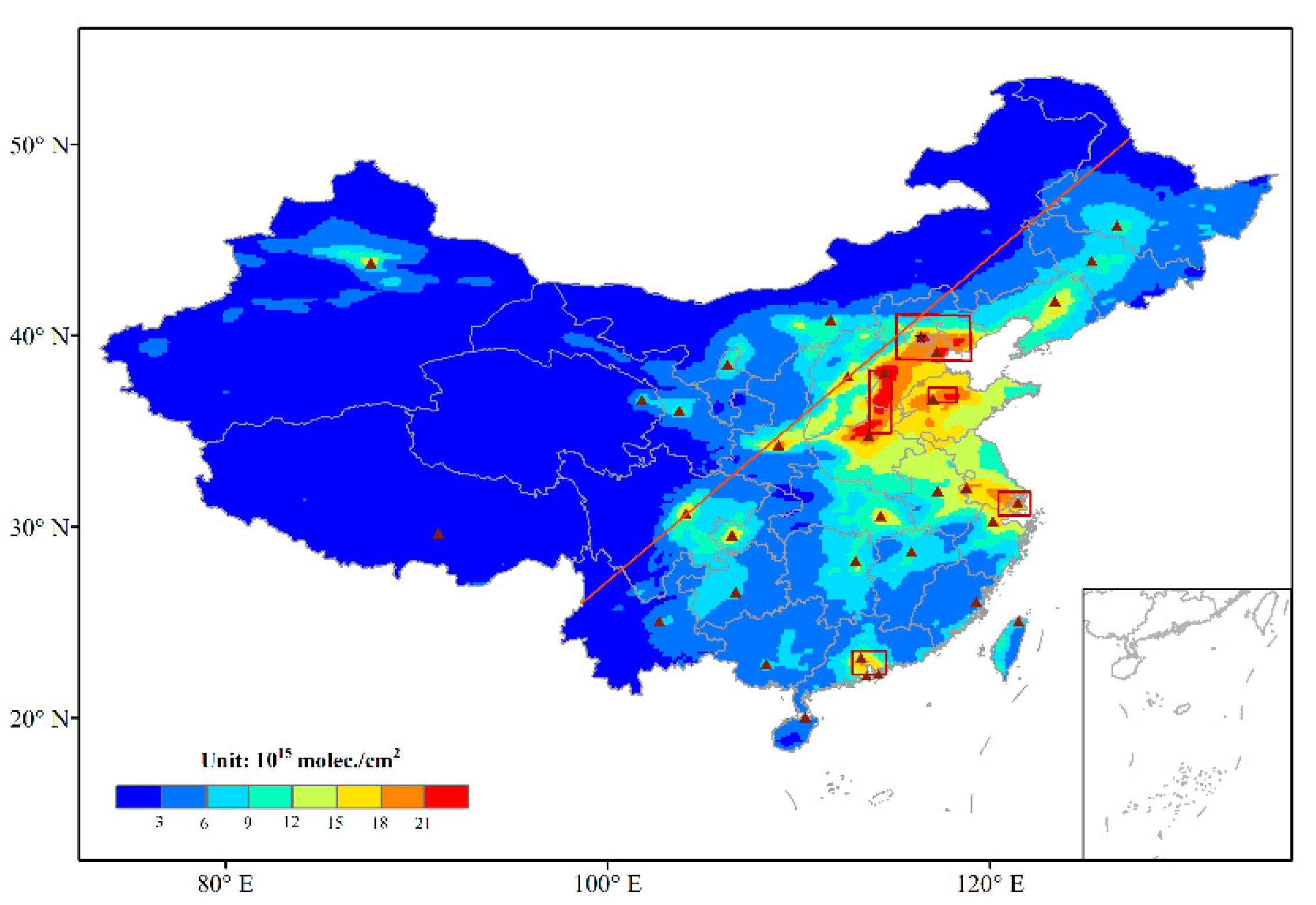
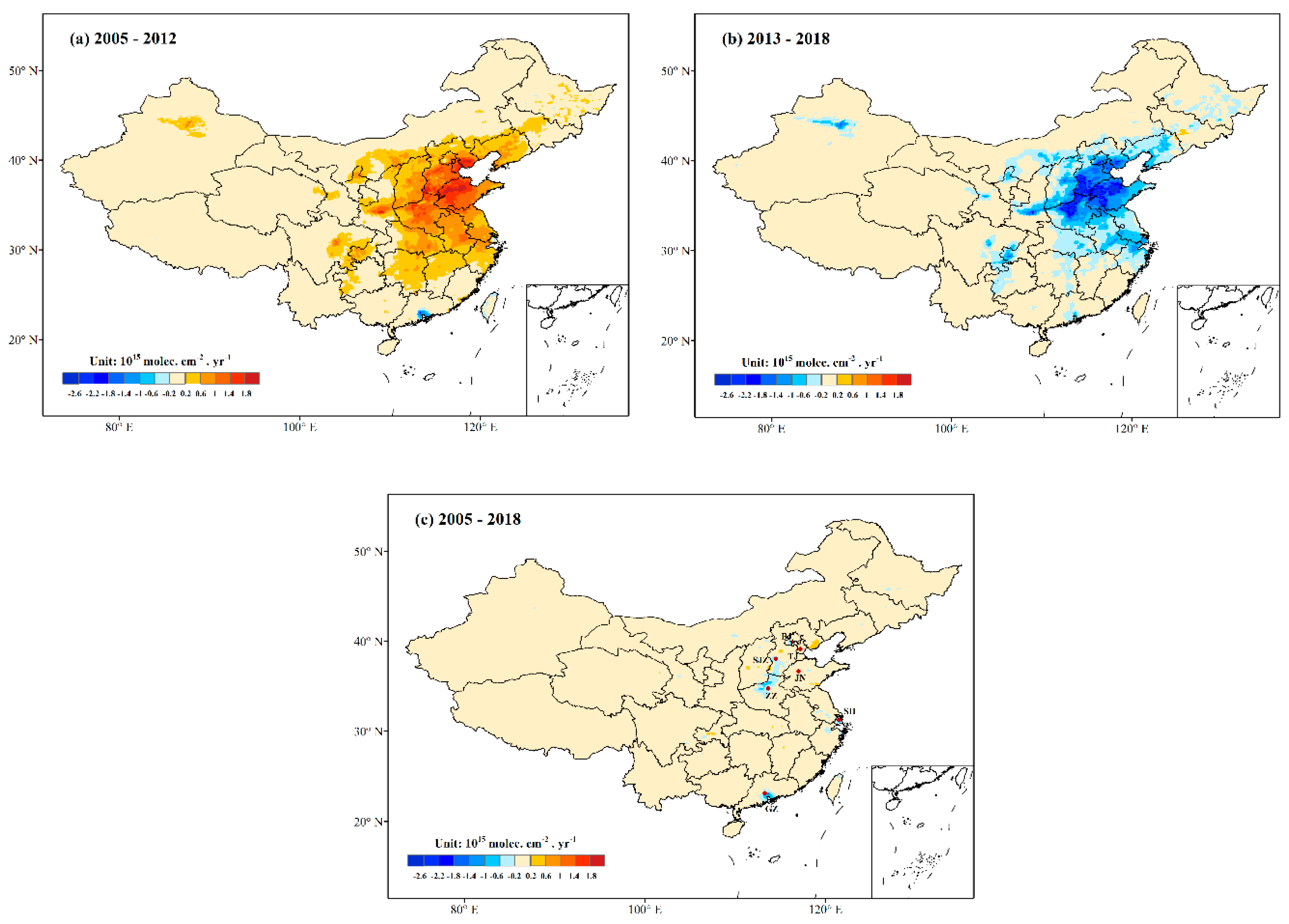
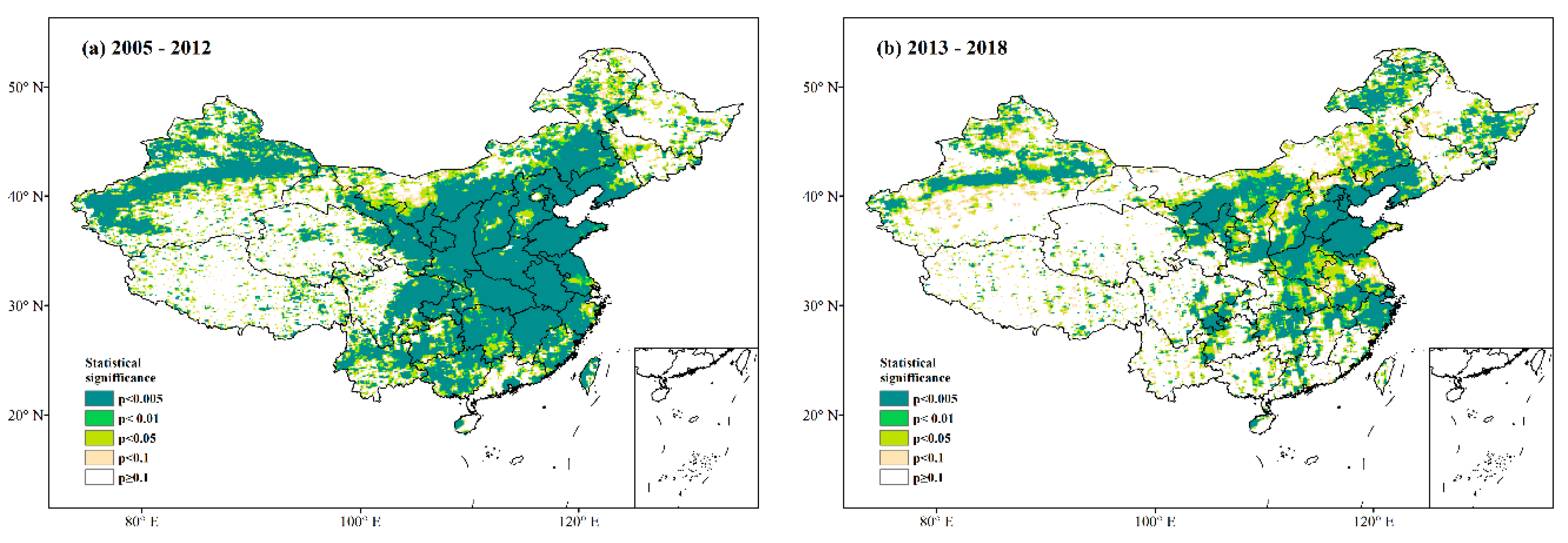
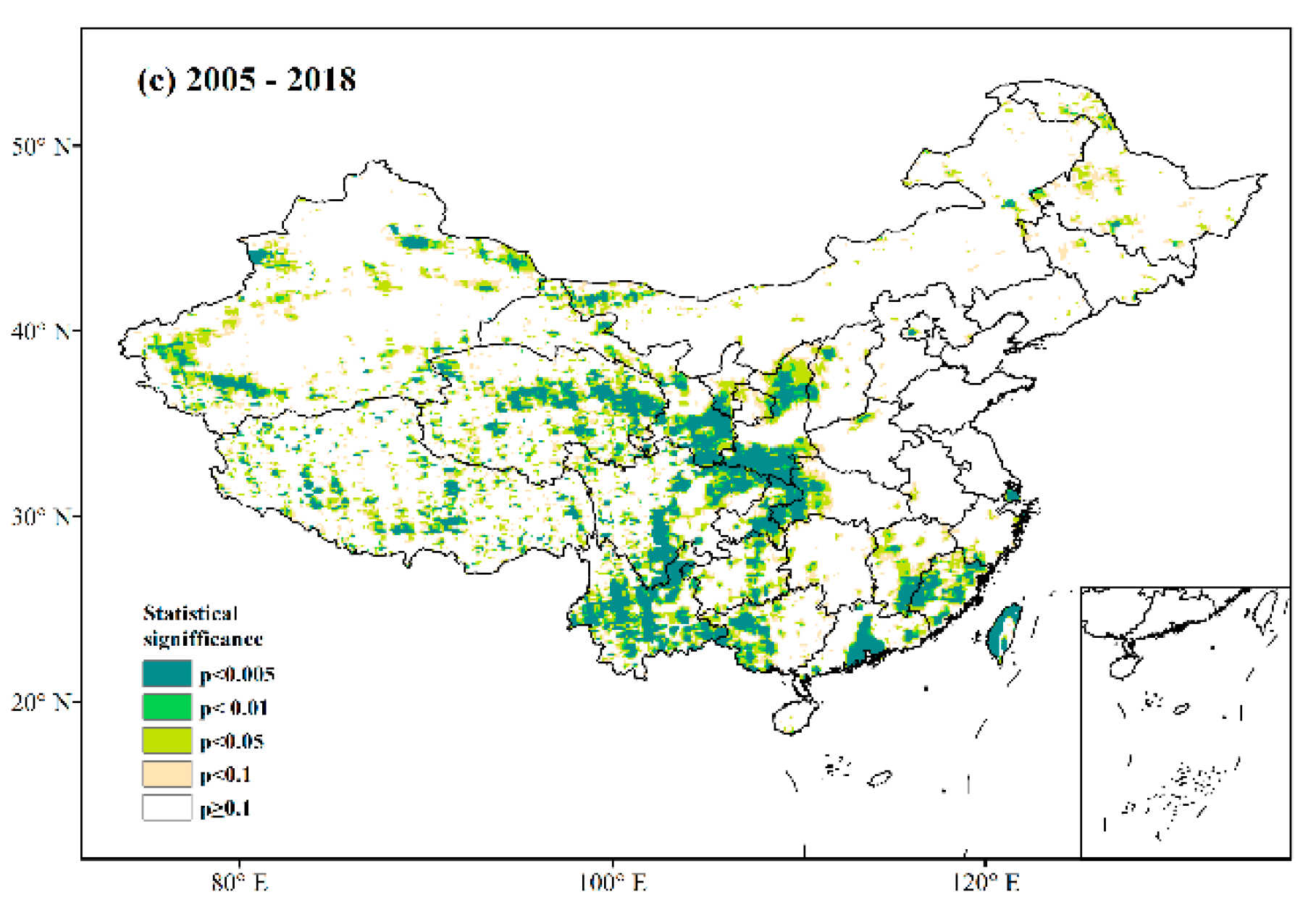
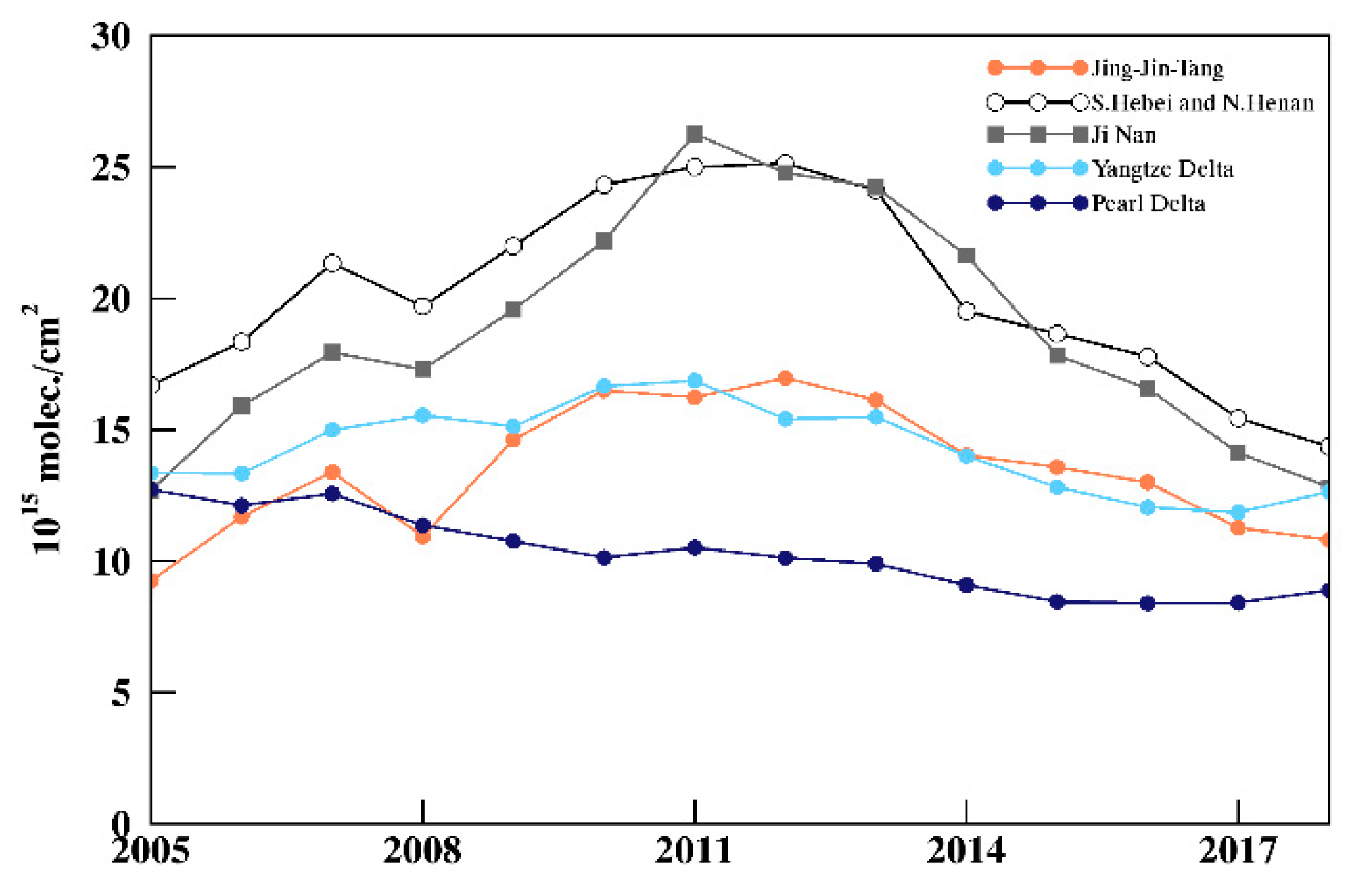
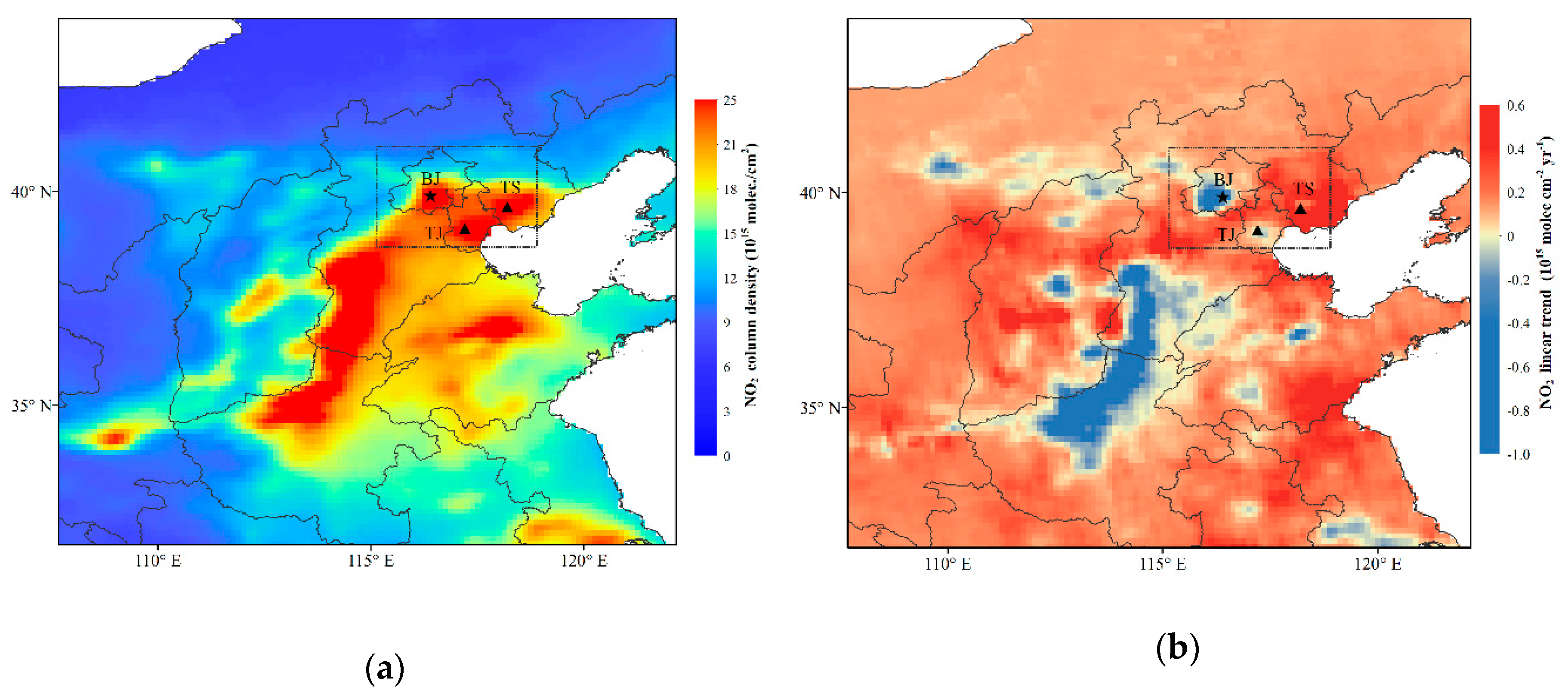
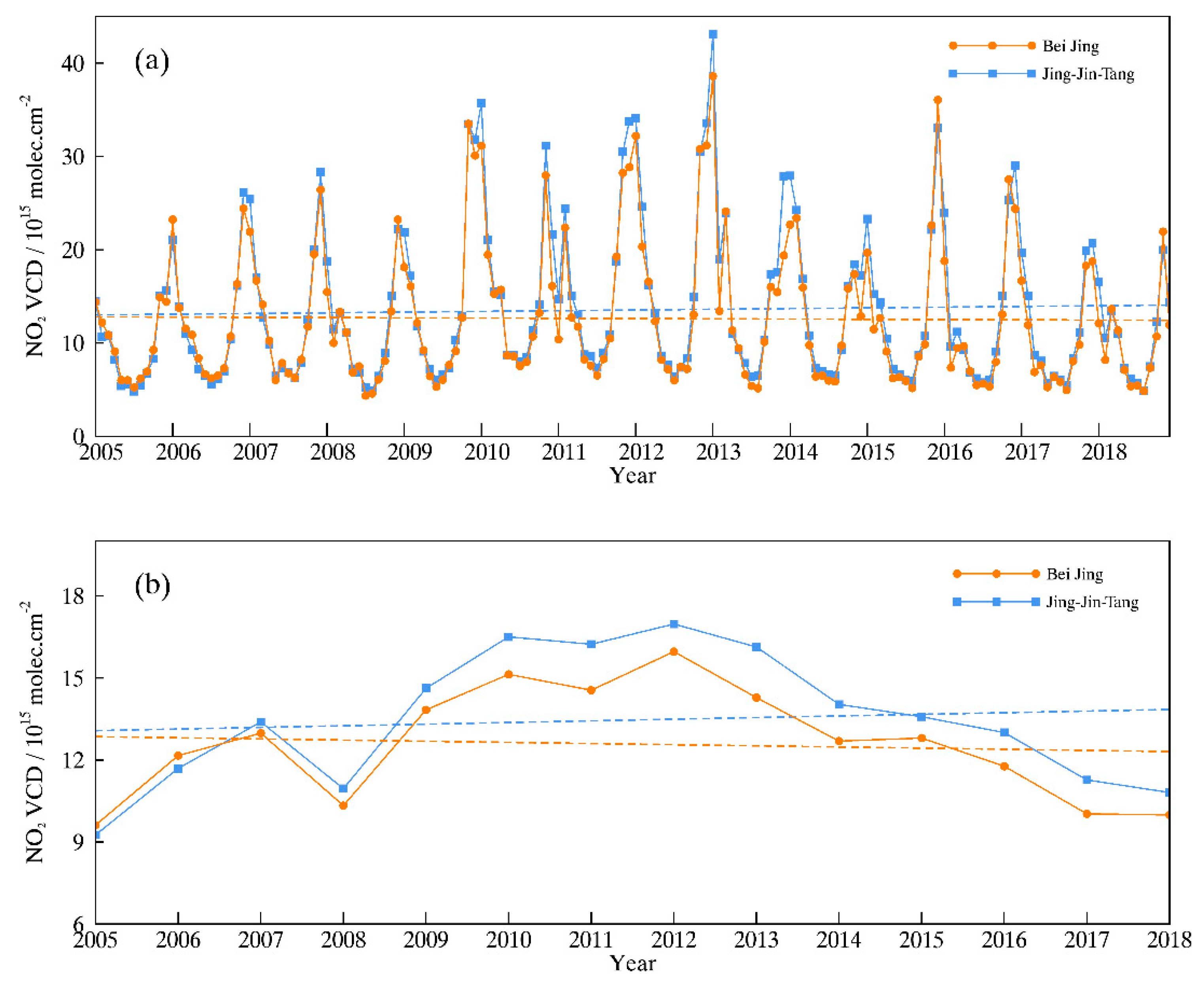
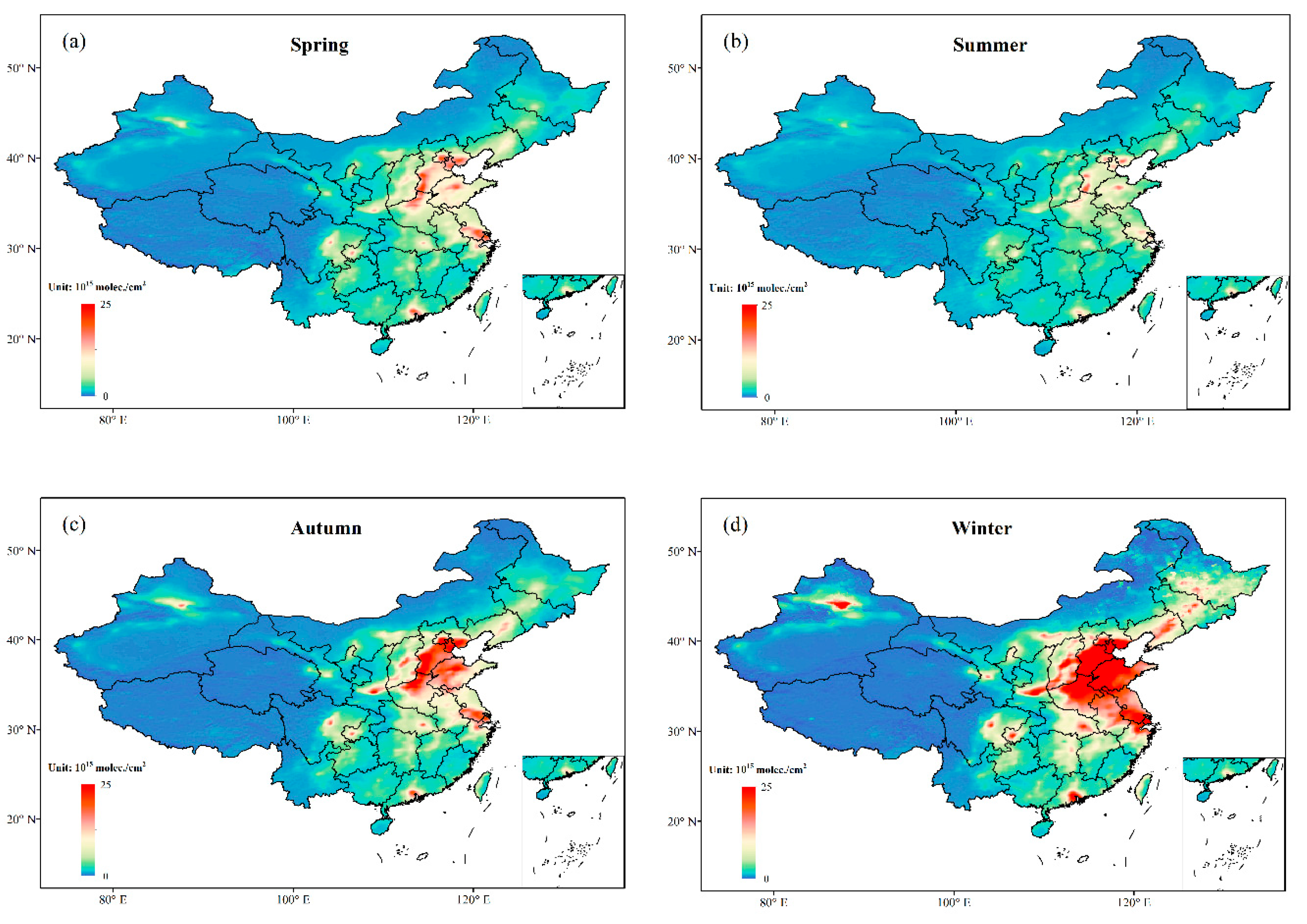
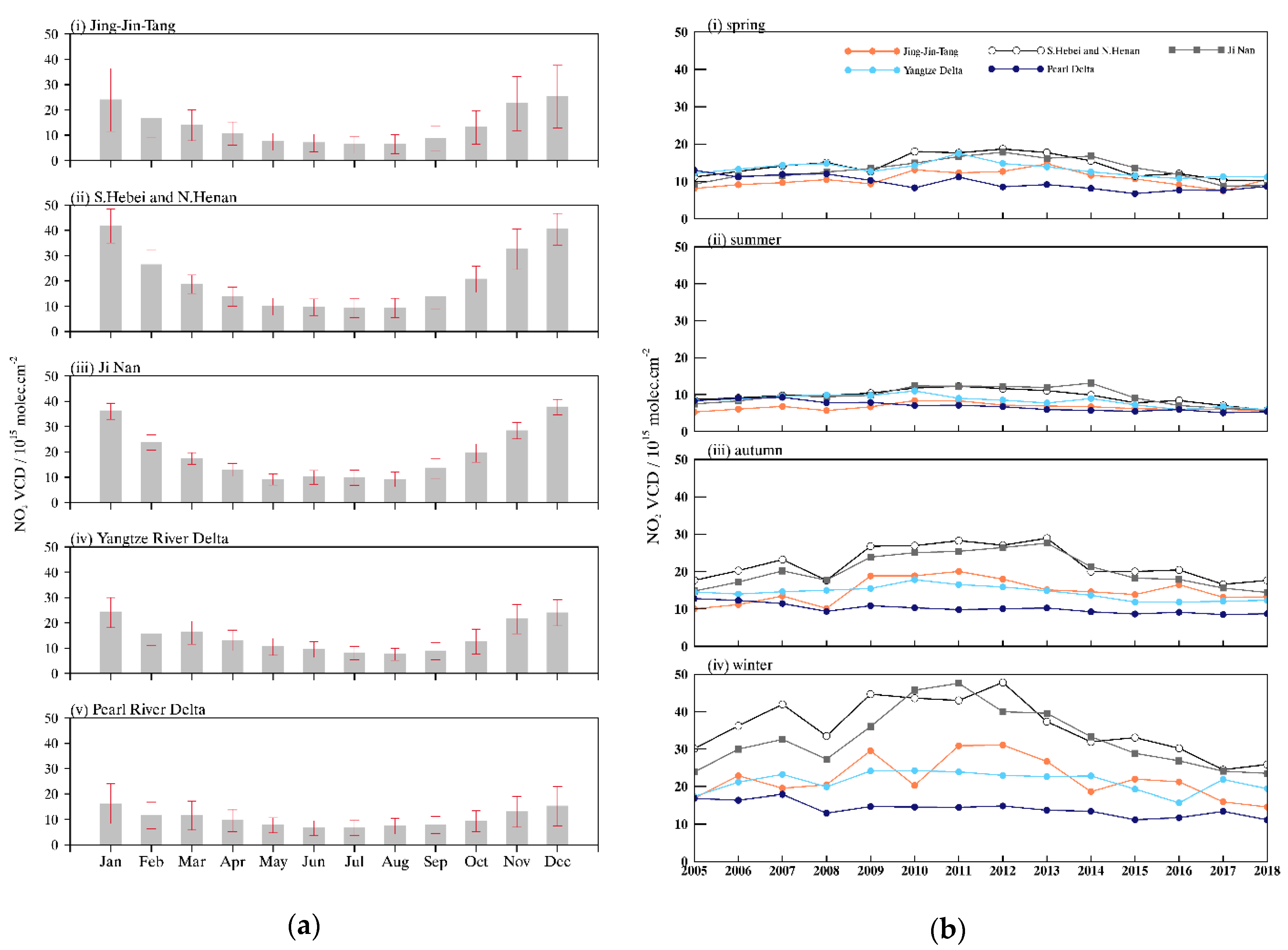
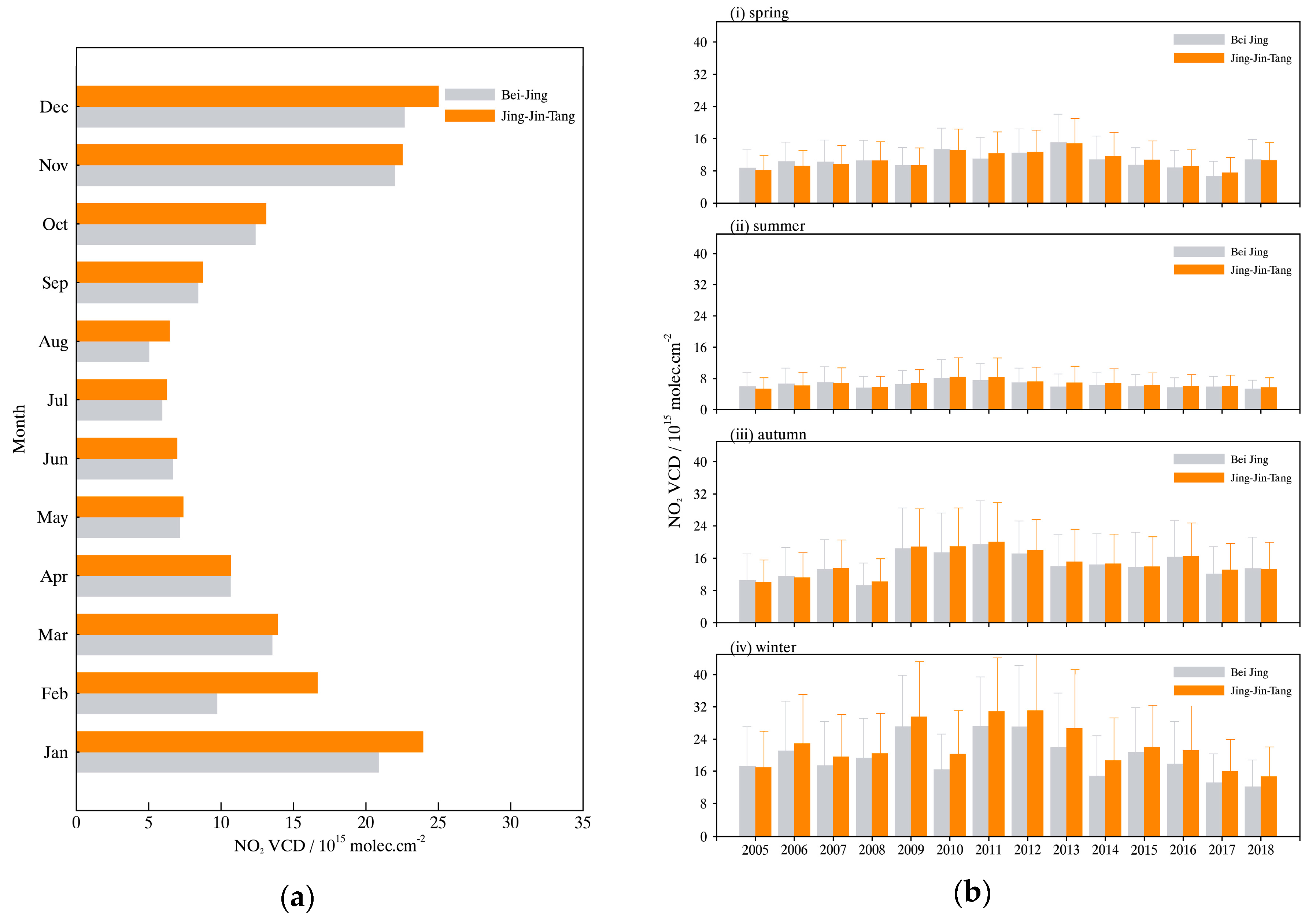
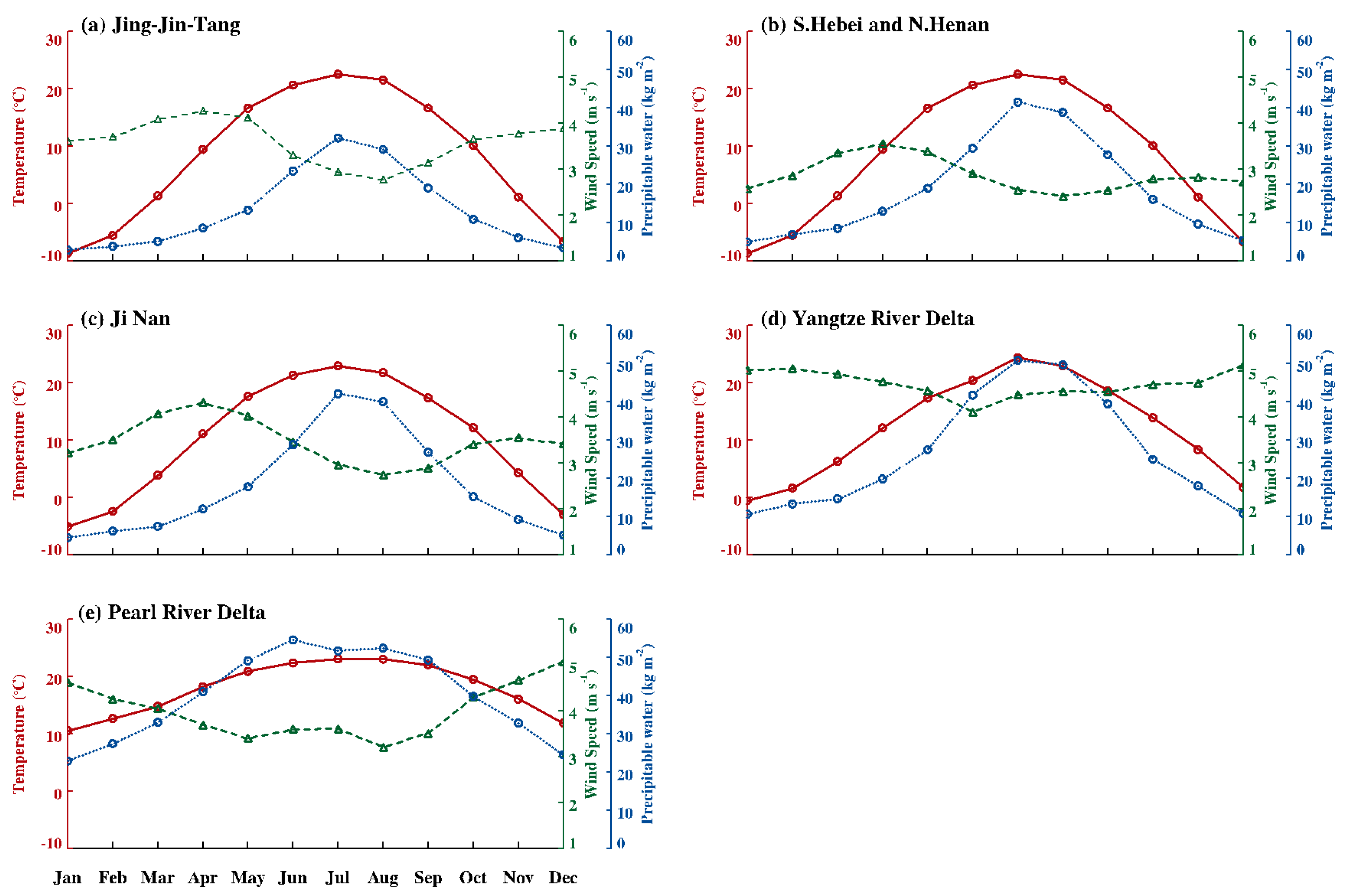
| Year of Implementation | Regulation | Main Goals | Reference |
|---|---|---|---|
| 2006–2010 | The 11th five-year plan | The SO2 should be reduced by 10% from 2005 to 2010, but it lacks effective measures to reduce NOx emission. | Ma et al. [45] |
| 2011–2015 | The 12th five-year plan | The NOx should be reduced by 10% from 2011 to 2015. | Chinese National Government [46] |
| 2012 | Ambient air quality standards (GB3095-2012) | The concentration limitation of atmosphere NOx in China has been issued. | Van der A et al. [41] |
| 2013 | The Air Pollution Prevention and Control Action Plan | Aimed to improve the national air quality, especially in Beijing–Tianjin–Hebei, Yangtze River Delta and Pearl River Delta. | CAAC [48] |
| 2013–2017 | APPC-AP | PM2.5 pollution has been paid more attention to. | Ma et al. [45] |
| 2016–2020 | The 13th five-year plan | It insists upon the goal of energy conservation and emission reduction. | Chinese National Government [47] |
| City | 2005 | 2012 | 2018 | Rate of Change (2005–2012) (%) | Rate of Change (2012–2018) (%) |
|---|---|---|---|---|---|
| Beijing | 9.62 | 15.96 | 9.99 | 65.9 | −37.4 |
| Tianjin | 14.25 | 24.37 | 15.57 | 71.0 | −36.1 |
| Shijiazhuang | 14.32 | 21.50 | 14.20 | 50.1 | −34.0 |
| Zhengzhou | 14.94 | 24.16 | 13.01 | 61.7 | −46.2 |
| Jinan | 12.70 | 24.78 | 12.83 | 95.1 | −48.2 |
| Shanghai | 11.82 | 12.77 | 10.63 | 8.0 | −16.8 |
| Guangzhou | 14.48 | 10.85 | 9.23 | −25.1 | −14.9 |
© 2019 by the authors. Licensee MDPI, Basel, Switzerland. This article is an open access article distributed under the terms and conditions of the Creative Commons Attribution (CC BY) license (http://creativecommons.org/licenses/by/4.0/).
Share and Cite
Wang, C.; Wang, T.; Wang, P. The Spatial–Temporal Variation of Tropospheric NO2 over China during 2005 to 2018. Atmosphere 2019, 10, 444. https://doi.org/10.3390/atmos10080444
Wang C, Wang T, Wang P. The Spatial–Temporal Variation of Tropospheric NO2 over China during 2005 to 2018. Atmosphere. 2019; 10(8):444. https://doi.org/10.3390/atmos10080444
Chicago/Turabian StyleWang, Chunjiao, Ting Wang, and Pucai Wang. 2019. "The Spatial–Temporal Variation of Tropospheric NO2 over China during 2005 to 2018" Atmosphere 10, no. 8: 444. https://doi.org/10.3390/atmos10080444
APA StyleWang, C., Wang, T., & Wang, P. (2019). The Spatial–Temporal Variation of Tropospheric NO2 over China during 2005 to 2018. Atmosphere, 10(8), 444. https://doi.org/10.3390/atmos10080444




